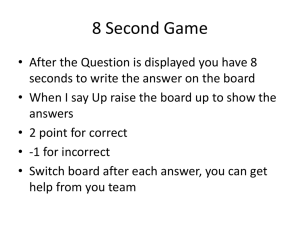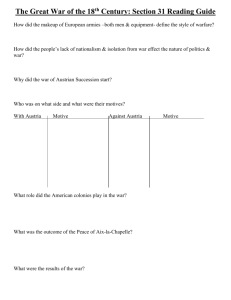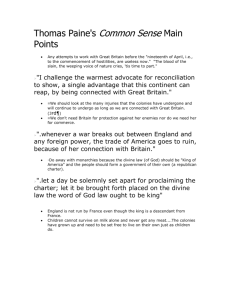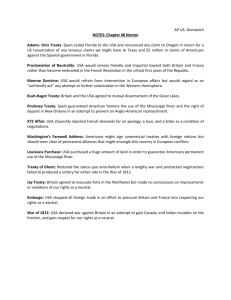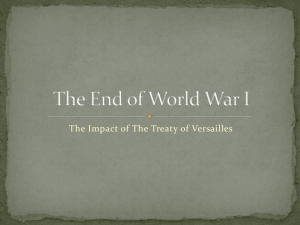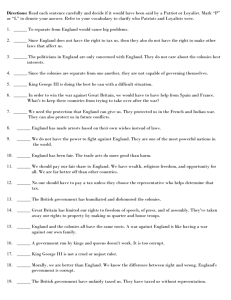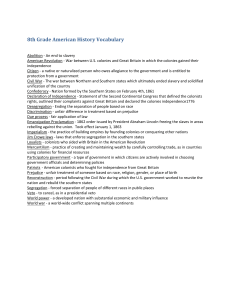Worksheet part 2
advertisement
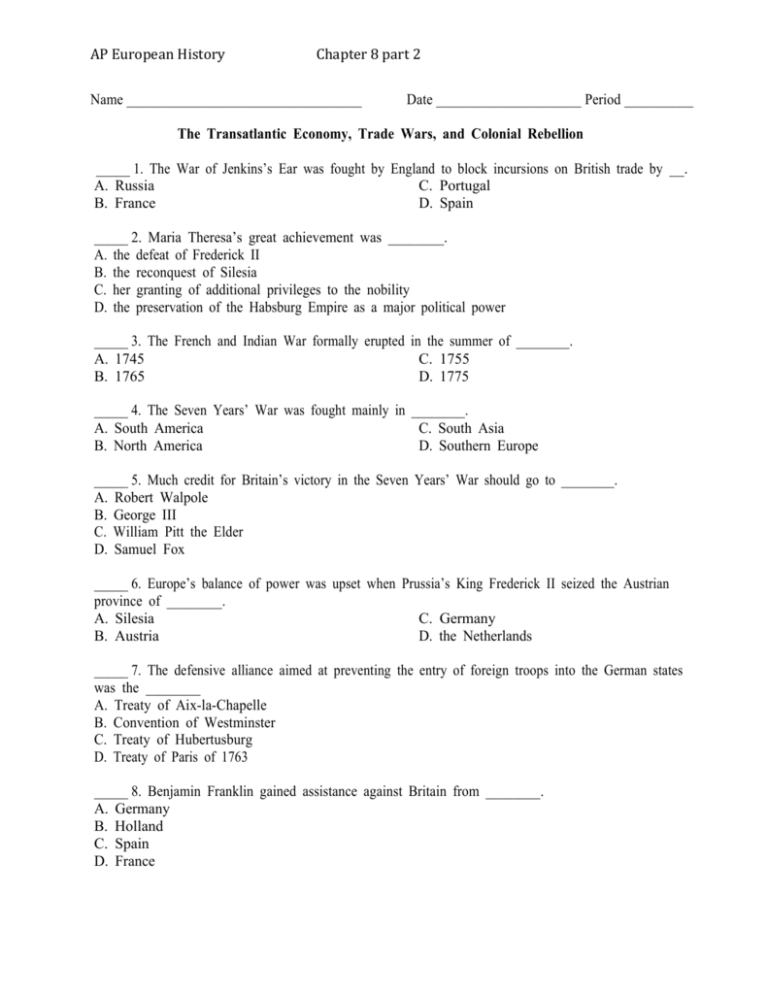
AP European History Chapter 8 part 2 Name __________________________________ Date _____________________ Period __________ The Transatlantic Economy, Trade Wars, and Colonial Rebellion _____ 1. The War of Jenkins’s Ear was fought by England to block incursions on British trade by __. A. Russia C. Portugal B. France D. Spain _____ 2. Maria Theresa’s great achievement was ________. A. the defeat of Frederick II B. the reconquest of Silesia C. her granting of additional privileges to the nobility D. the preservation of the Habsburg Empire as a major political power _____ 3. The French and Indian War formally erupted in the summer of ________. A. 1745 C. 1755 B. 1765 D. 1775 _____ 4. The Seven Years’ War was fought mainly in ________. A. South America C. South Asia B. North America D. Southern Europe _____ 5. Much credit for Britain’s victory in the Seven Years’ War should go to ________. A. Robert Walpole B. George III C. William Pitt the Elder D. Samuel Fox _____ 6. Europe’s balance of power was upset when Prussia’s King Frederick II seized the Austrian province of ________. A. Silesia C. Germany B. Austria D. the Netherlands _____ 7. The defensive alliance aimed at preventing the entry of foreign troops into the German states was the ________ A. Treaty of Aix-la-Chapelle B. Convention of Westminster C. Treaty of Hubertusburg D. Treaty of Paris of 1763 _____ 8. Benjamin Franklin gained assistance against Britain from ________. A. Germany B. Holland C. Spain D. France AP European History Chapter 8 part 2 _____ 9. The Diplomatic Revolution of 1756 was ________. A. a new idea of how alliances could be used B. a shift in alliances C. the alliance of most of Europe against Austria D. a division of Europe into east and west _____ 10. The act that put a tax on legal documents and other items such as newspapers was the ______. A. Stamp Act C. Intolerable Acts B. Sugar Act D. Declaratory Act _____ 11. Britain changed the outcome of the Seven Years’ War when it came to the aid of ________. A. France C. Prussia B. Austria D. Russia _____ 12. The war that gave the world a successful government without kings was the ________. A. Seven Years’ War B. War of Jenkins’s Ear C. American Revolution D. War of Austrian Succession _____ 13. The intendants used by Charles III amounted to an expansion of _________. A. slavery C. the power of the creoles B. royal power D. sugar cultivation _____ 14. The leader of the Yorkshire Association Movement was ________. A. Christopher Wyvil C. John Wilkes B. Lord North D. William Pitt the Younger _____ 15. The commercial empires of the 1700s were a feature of the _________stage of European imperialism. A. first C. third B. second D. fourth _____ 16. According to the text, which of the following were closely related? A. warfare in West Africa and slavery in the Americas B. warfare in Latin America and the political development of the Ohio River valley C. warfare in Eastern Europe and the political development of the American colonies D. warfare in Western Europe and the economic development of Indian commerce _____ 17. What two areas were often the source of conflict and wars between the great powers in the mid-eighteenth century? A. China and the access to the Mediterranean Sea B. the African coast and access to the Mediterranean Sea C. overseas empires and central and eastern Europe D. overseas empires and western Europe AP European History Chapter 8 part 2 _____ 18. Frederick II’s invasion of Silesia offset the continental balance of power and ________. A. drew England into a war in North America B. shattered the provisions of the Pragmatic Sanction C. led to the defeat of the Spanish trade monopoly D. sparked the outbreak of the Seven Years’ War _____ 19. The war over the Austrian succession and the British-Spanish commercial conflict might have remained separate disputes; what united them was the ________. A. role of France B. immediate British conquest of the French colonies C. slow-moving Prussian threat to the Low Countries D. lasting Prussian threat to France _____ 20. At the outbreak of the French and Indian War, new political alliances formed in Europe and included an alliance between ________. A. Prussia and Austria B. Great Britain and Austria C. France and Great Britain D. France and Austria _____ 21. From the British victory in the French and Indian War, Great Britain became not only a European power, but also a world power until ________. A. the worldwide depression in the 1930s B. World War I C. World War II D. the beginning of the Cold War _____ 22. What was the outcome of the 1783 Treaty of Paris? A. The treaty granted independence to the American colonies. B. The treaty granted control of all of Canada and the eastern half of the Mississippi River valley to Britain. C. The treaty ended the Seven Years’ War. D. The treaty preserved the Habsburg dynasty. _____ 23. At the conclusion of the French and Indian War, what two imperial problems did the British government face? A. the costs of maintaining its empire and the vast expanse of new territory in North America that it had to organize B. how to protect itself from the Spanish Empire in North America and the loss of its North American territories C. how to integrate the French-speaking territories peacefully into British holdings and the costs of maintaining its empire D. the vast expanse of new territory in North America that it had to organize and how to avoid a Spanish attack on its newly conquered land AP European History Chapter 8 part 2 _____24. After 1713, what did the following colonies have in common: Nova Scotia, Newfoundland, Bermuda, Jamaica, and Barbados? A. They were all founded by Christopher Columbus. B. They were all important sugar producers. C. They all relied on slave labor. D. They were all British colonies. _____ 25. What was one of the most important causes that drove European nations to increase their taxes in the mid-eighteenth century? A. They wished to settle more colonies in the New World. B. They wished to import more slaves from Africa. C. They wished to increase their trade networks. D. They had to pay off their war debts from prolonged wars. _____ 26. What advantage did the peninsulares receive in the Spanish Colonies? A. They received land. B. They received the revenue from silver mines. C. They received the best, most profitable jobs in the region. D. They were treated like second-class citizens. _____ 27. The Yorkshire Association Movement was started in England to ________. A. reduce taxes C. abolish slavery B. decrease involvement in foreign wars D. reform the government _____ 28. What were the terms of the Treaty of Paris of 1763? A. Britain received all of Canada, the Ohio River valley, and the eastern half of the Mississippi River valley. B. The American colonies were granted independence from Britain. C. The continental conflict of the Seven Years’ War ended with no significant changes in prewar borders. D. Spain received all of South America as well as areas in North America, including Florida, Mexico, California, and the Southwest. _____ 29. What was the British motivation for passing the Stamp Act and the Sugar Act? A. Britain wanted to exert authority over the unruly colonists. B. Britain needed to raise money to pay its debts. C. Britain was losing money on sugar and legal papers. D. The British Parliament was feeling pressure from citizens to force more contributions from the colonists. _____ 30. The American Revolution had what effect on British policy in the short term? A. The pace of reform increased. B. The Yorkshire Movement quickly achieved its aims. C. Some reforms were achieved. D. The country underwent a reactionary period.
